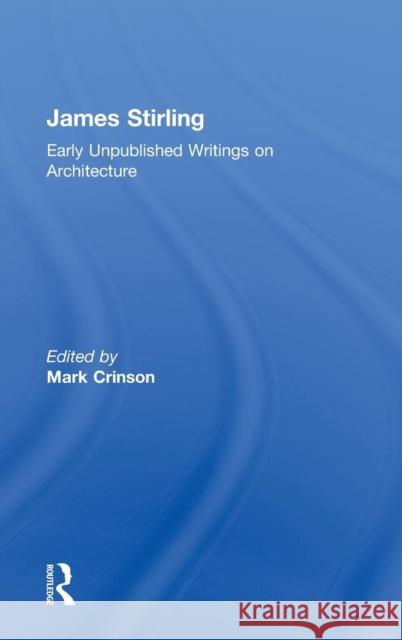James Stirling: Early Unpublished Writings on Architecture » książka
James Stirling: Early Unpublished Writings on Architecture
ISBN-13: 9780415550581 / Angielski / Twarda / 2009 / 160 str.
James Stirling: Early Unpublished Writings on Architecture
ISBN-13: 9780415550581 / Angielski / Twarda / 2009 / 160 str.
(netto: 832,77 VAT: 5%)
Najniższa cena z 30 dni: 856,36
ok. 22 dni roboczych
Dostawa w 2026 r.
Darmowa dostawa!
James Stirling (1924-1992) was, arguably, the most influential and controversial post-war British architect. Stirling's reputation is based primarily on such seminal buildings as the Leicester University Engineering Building (1959-63, with James Gowan), at one end of his career, and the Neue Staatsgalerie Stuttgart (1977-83, with Michael Wilford) at the other. Although he denied both labels, his work is seen as central to New Brutalism and Post-Modernism and his buildings attracted commentary and theory from the leading architectural thinkers of the day (including Frampton, Tafuri, Eisenman and Banham). Despite his significance, however, there has been very little recent research or creative re-interpretation of his work. This fascinating insight into Stirling's work presents previously unavailable writings by him as well as new research on his early career, including:
- 'The Black Notebook' - the journal he kept in the mid-1950s
- the recorded talk he gave to the 'Team 10' group in 1962, as well as the discussion that followed that talk
- three sets of notes for lectures he gave
- an interview with Stirling and Gowan
- essays by the editor placing the texts in the context of Stirling's early work and discussing Stirling's relation to Le Corbusier.
James Stirling (1924-1992) was, arguably, the most influential and controversial post-war British architect. Stirling’s reputation is based primarily on such seminal buildings as the Leicester University Engineering Building (1959-63, with James Gowan), at one end of his career, and the Neue Staatsgalerie Stuttgart (1977-83, with Michael Wilford) at the other. Although he denied both labels, his work is seen as central to New Brutalism and Post-Modernism and his buildings attracted commentary and theory from the leading architectural thinkers of the day (including Frampton, Tafuri, Eisenman and Banham). Despite his significance, however, there has been very little recent research or creative re-interpretation of his work.
This fascinating insight into Stirling’s work presents previously unavailable writings by him as well as new research on his early career, including:
- 'The Black Notebook' - the journal he kept in the mid-1950s;
- the recorded talk he gave to the Team 10 group in 1962, as well as the discussion that followed that talk;
- three sets of notes for lectures he gave;
- an interview with Stirling and Gowan;
- essays from the editor placing the texts in the context of Stirling’s early work and discussing Stirling’s relation to Le Corbusier.
Profusely illustrated, with many photographs taken by Stirling himself, this book gives fresh understanding of Stirling’s early career and the reasons why avant-garde architecture in post-war Britain became so widely influential outside the country.











